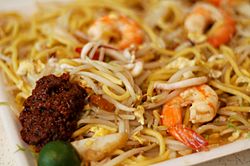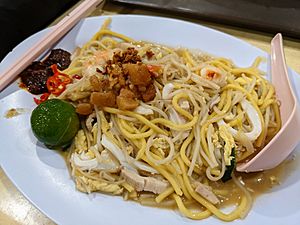Hokkien mee facts for kids

Singaporean-style Hokkien Mee
|
|
| Type | Noodle |
|---|---|
| Place of origin | Fujian province, China |
| Associated national cuisine | Indonesia, Malaysia, Singapore |
| Main ingredients | Egg noodles, rice noodles, egg, pork, prawn, squid |
| Variations | Hokkien hae mee, Hokkien char mee |
| Hokkien mee | |||||||||||
|---|---|---|---|---|---|---|---|---|---|---|---|
| Traditional Chinese | 福建麵 | ||||||||||
| Simplified Chinese | 福建面 | ||||||||||
| Hokkien POJ | Hok-kiàn mī | ||||||||||
| Literal meaning | Hokkien noodles | ||||||||||
|
|||||||||||
| Hae mee | |||||||||||||||
|---|---|---|---|---|---|---|---|---|---|---|---|---|---|---|---|
| Traditional Chinese | 蝦麵 | ||||||||||||||
| Simplified Chinese | 虾面 | ||||||||||||||
| Literal meaning | Prawn noodles | ||||||||||||||
|
|||||||||||||||
Hokkien mee, which means "Fujian noodles," is a group of popular dishes from Southeast Asia. These tasty noodle dishes first came from the Fujian province in China.
Contents
Types of Hokkien Mee Dishes
The name Hokkien mee can actually mean four different dishes. Each one is very popular in certain places like Singapore, Malaysia, and Indonesia. Even though they started in Fujian, these specific dishes are now unique to Southeast Asia. They are all thought to have come from a Fujian dish called lor mee.
Here are the main types of Hokkien mee:
- Singaporean Hokkien mee (fried noodles): This dish is stir-fried. It uses egg noodles and rice noodles. It does not use dark soy sauce. Key ingredients include egg, prawns, squid, fish cake, and pork. It often comes with lard, limes, and sambal chili.
- Penang hae mee (prawn noodles): This is a noodle soup. It uses egg noodles and rice noodles. It does not use dark soy sauce. The main ingredient is prawn, with chicken or pork, egg, kangkung, and sambal chili.
- Singaporean hae mee (prawn noodles): This is also a noodle soup. It uses egg noodles and rice noodles. It does not use dark soy sauce. The main ingredient is prawn, with chicken or pork, squid, and fish cake.
- Hokkien char mee (fried noodles): This dish is stir-fried. It uses thick yellow noodles. Dark soy sauce is a key ingredient. It includes chicken or pork, squid, and cabbage.
Singaporean Hokkien Mee
In Singapore, Hokkien mee (福建面) is a dish of egg noodles and rice noodles. These noodles are stir-fried with egg, slices of pork, prawns, and squid.
A very important part of this dish is the flavorful broth. It is made from prawns and pork bones, cooked slowly for many hours. Sambal chili and calamansi limes are served on the side. You can mix them in for an extra spicy and tangy taste.
Traditionally, small pieces of fried lard are added. Some food stalls even serve the dish on an opeh leaf (a soft areca palm bark). This helps make the dish smell even better.
This Singaporean version of Hokkien mee was created after World War II. Chinese sailors from Fujian province made it. After working, they would fry extra noodles over a charcoal stove. This dish is now a classic part of Singaporean cuisine. Some hawker stalls selling it have even been recognized by the Michelin Guide.
This dish is also known as "fried Hokkien noodles" or "Hokkien fried prawn noodles." In Malaysia, it is sometimes called "sotong mee" (squid noodles). This helps tell it apart from other types of Hokkien mee.
In Indonesia, Mie Hokkien is especially popular in the city of Medan. The ingredients are similar to the Singaporean version. However, instead of stir-frying everything together, the ingredients are usually cooked separately. Then, they are simply tossed together before serving.
Penang Hae Mee (Noodle Soup)
The Penang version of Hokkien mee is easy to spot because of its spicy prawn broth. It mainly has rice vermicelli and thicker yellow egg noodles. The broth is made with prawn heads, shells, and pork ribs.
Sliced prawns are added to the dish. You will also find pork slices, hard-boiled eggs, kangkung (a type of water spinach), bean sprouts, fried shallots, lard, and sambal chili. In Penang, pig skin is a common topping.
Egg noodles are served in a rich, dark soup stock. This soup has prawns, pork slices, fish cake slices, and bean sprouts. It is topped with fried shallots and scallion. The stock is made using dried shrimp, prawn heads, white pepper, garlic, and other spices.
Traditionally, lard was added to the soup. However, this is less common now due to health reasons. A "dry" version is also available. This version usually has noodles and toppings flavored with vinegar, soy sauce, oil, and chili. The dish is often served with fresh red chili slices in light soy sauce and lime juice.
Singaporean Hae Mee
Another dish called "prawn noodles" in Singapore is similar to the Penang version of Hokkien mee. Egg noodles and rice noodles are served in a rich, dark soup stock. This soup includes prawns, pork slices, fish cake slices, and bean sprouts. It is topped with fried shallots and spring onion. The stock is made using dried shrimps, prawn heads, white pepper, garlic, and other spices.
Hokkien Char Mee
Hokkien char mee (Hokkien fried noodles; 福建炒麵) is served in Kuala Lumpur and nearby areas. It is a dish of thick yellow noodles cooked in a thick, dark soy sauce. The main ingredients are pork, squid, fish cake, and cabbage. It also has crispy fried cubes of pork fat. Sometimes, pork liver is included. The best versions are often cooked over a hot charcoal fire. Unlike the other types of Hokkien mee, this dish does not use prawns. This dish was first created by a hawker stall chef, Ong Kim Lian, in 1927.
See also
 In Spanish: Hokkien mee para niños
In Spanish: Hokkien mee para niños





